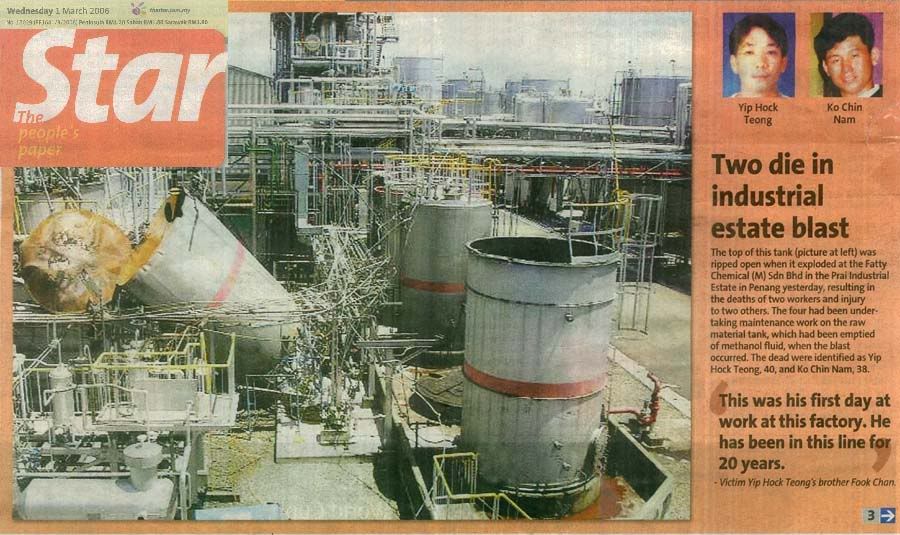Flashpoint: Was the Prai explosion avoidable?
Those acquainted with the real life Walski know that I earn my keep in the process automation industry. Those that aren't acquainted - well, now you know. I was pretty taken aback by the tragic industrial accident at the Fatty Chemicals plant in Prai. The blast, has resulted in three deaths - two instantly, and the third in hospital, succumbing to serious burns covering more than 70% of the body. The Malaysian Department of Occupational Safety and Health (DOSH) has launced an investigation (or will very soon), and hopefully the result of the investigation will be made public. But the saddest part about the Prai incident - based on my experience - is that it could have been avoided. There are numerous plants around the country that generate Methanol and/or Hydrogen for use within the facility, particularly at oleochemical plants. Know one in your neighborhood? In the case of Fatty Chemicals, they have both. As do numerous other oleochemical plants country-wide. And it is very, very fortunate that the Hydrogen tank was far away enough to not be affected; the blast would have obliterated the entire process area had it been any closer. From what I have surmised from reading the news reports, the four-crew welding team was about to start welding works on the tank when it exploded. Looking at the extent of the damage (from the picture), the tank would have had to have pressurized methanol gas. The first question that comes to mind: wasn’t a gas test done prior to the start of welding works? For those unfamiliar with process plant maintenance (for those who are, you may skip to the next paragraph), any work to be done on site must be authorized, through what’s generally known as the “Permit to Work” system. The various types of work can be characterized as either Hot or Cold Works. Hot Work would be maintenance activities involving either flammable (or otherwise hazardous) materials – Methanol included – or high voltage electrical work. Process areas are classified into zones, depending on the level of exposure to flammable gas. In this particular case, doing welding work (which provides an ignition source) on a Methanol tank, well, is a double-whammy. But such work is allowed provided that: Were all these steps taken? That’s what DOSH would need to investigate. The extent of the damage indicates to me that the tank was not vented and that there was a significant amount of Methanol remaining. Other questions that come to mind: If there was a fair bit of Methanol still in the tank, why did it not register on the process control system or on the local tank level indicator? Since the incident occurred during a plant shutdown period, were safety procedures contravened? More questions for DOSH to uncover, it seems. In my opinion, as a process control professional, accidents like these can be averted if all the safety and Permit to Work procedures are strictly adhered to. Going through the paces of the permit and safety processes, just for the sake of expediency can prove fatal, as the case may have been at the Fatty Chemicals plantsite. Some contractors do see these procedures as a pain in the ass sometimes – but they’re there for a reason. The primary reason manifested itself last Wednesday – to avert the loss of life and property. And this is not the first time welding works on storage tanks or vessels has resulted in explosion and loss of life. Similar accidents have happened at shipyards, while welding work was being carried out on ship storage tanks, particularly those carrying hydrocarbon products. I have been to enough industrial process sites to know that sometimes safety and process integrity take a back seat to implementation cost. When it comes to plant instrumentation, for example, the cheapest, and not the most accurate or reliable, are frequently selected. Control systems, way overdue for modernization are retained well beyond their shelf-life – simply because the cost to modernize is seen as “too high”. When it comes to procedures to ensure a safe working environment, critical procedures like nitrogen flushing are skipped because it adds to operations and maintenance costs. Let’s hope that this was not the case at Fatty Chemicals. No amount of capital cost-savings can bring back the lives of Yip Hock Teong, Ko Chin Nam and M. Kunesekaran. Human life, after all, is one capital cost that you cannot put a pricetag on.
















